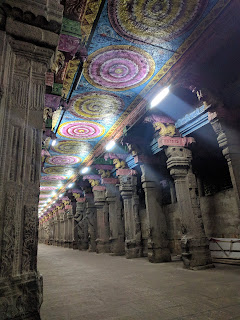Dear readers, I have arrived! As I write this, I am swaddled in a silk dressing gown in our jetlag recovery hotel in Chennai. Kate, my Boston friend and traveling companion/tour guide for the India portion of my journey (she lived in south India for 2 years), recommended we spend the first night recuperating and sleeping, and I'm so glad we did. This is possibly the nicest hotel I have ever stayed in, with an ample free breakfast, foot massages, and comfy bed. (Radisson Chennai near the airport, if anybody cares to repeat.) When we stumbled in, bleary and exhausted, we were greeted with a magnificent spread, every dish of which was labeled with its nutritional merits, sometimes to our incredulity. Gulab jamun, an Indian sweet made of deep fried dough soaked in sugar syrup, was declared "high fiber" and "rich in carbohydrates." Thick, creamy stews were "high energy." Nutritional wand-wavings aside, it truly was delectable: idli sambar, a bread-y patty with a consistency similar to polenta served with spicy soup, poori (a flat round bread) served with vegetable stew, and fresh watermelon juice ensured I was very ready to hit the hay.
Left: Gulab Jamun. Right: Idli Sambar. Om nom nom.
While we're on the topic of food: I have also recently learned the art of eating with my hands. I say art because it was devilishly tricky for me at first. First, the bread: you generally have a mediumish flat round bread in front of you (naan and poori are examples), and you must place your fingers near the edge of the bread, brace the bread with your middle finger, and tear with your index and thumb. Then you take your bread piece and pinch the stew (curries, lentils, chunks of chicken in amazing tomato cream sauce) and voilà! You have a ready-to-eat bite in your hands.
One small miracle that has befallen me is that I have not yet been sick. To this I attribute good luck, Kate's warnings about what not to eat, bottled water, and magic probiotic pills that make me very gassy but defend me from worse ills. Hopefully I can avoid a serious case of the runs, but with 2 months on the road, I'm not optimistic.
Jetlag, on the other hand, has not been so kind. I had hoped my cleverly planned flight sleep schedule, with timing my sleep to match the new time zone, would help, but I did not sleep well on the plane and promptly took a 6 hour "nap" upon arrival in Chennai. That night, my body refused to sleep past 1am, and my second night fared only a bit better at a 5am wakeup. Kate keeps telling me it gets better from here, but I'm suspicious until I see results. The only plus side to waking early is listening to the city awaken. Some of these noises are hauntingly lovely, like the early morning song that calls Muslims to their first prayer. Others, not so much: my first morning in Madurai I thought heard half the city vomiting and coughing. Kate soon quelled my bubonic plague fears, but informed me that a typical morning habit here is to snort water up your nose and cough it out, which really did not make me feel any better. That is one cultural practice I will not be participating in.
Now, back to travel. Travel in India has thus far been a bit interesting, shall we say. Jet Airways, which flew me from London to Chennai, has excellent food--hot meals even on a 2 hour flight!--but the planes are a bit cramped and humid, and saxophone-heavy elevator music plays on takeoff and landing to disguise the noise. Landing in Chennai was another surprise: the plane landed at least 5 miles from the airport, as I discovered upon boarding a sweaty bus for a 20 minute ride to the terminal. The taxi from the airport gave me my first taste of Indian driving: there are no stop signs or traffic lights, only bravery.
Horns are used constantly, mostly just warn others of your presence, but also to turn--the more vigorous the beeping, the more likely you are to have someone yield. Consequently, the roads are quite a noisy place. There are also more motorbikes and rickshaws than cars on the road, and the sidewalks are not really used; instead, all traffic streams mingle together (human, vehicle, the occasional animal) and travel down the road in a large and only partially coordinated dance. Kate tells me there are many traffic fatalities, and it's easy to see why.
My second day in India, we flew to Madurai, a small city south of Chennai renowned for the Meenakshi temple within its borders. We visited the temple for a few hours, and it was lovely. No shoes allowed--I'm going to have to get used to grit between my toes --but the stone floors were well-swept.A walled courtyard surrounds the inner temple, with towering gates on all 4 sides of the courtyard. the gates are 60 meters high, intricately carved from wood and brightly painted with thousands of statues of gods decorating the heights. During the day, the stones of the courtyard soak up the sun and burn your feet, but near dusk, the stones are pleasantly warm, and a cool breeze softens the residual daytime heat.
We were lucky enough to also see the temple elephant, and he blessed me by tapping my head with his trunk, a boon I requested by proffering a 10 rupee note.
Above: the friendly elephant.
And now, dear readers, I must to bed. Goodnight!







The food looks yummy!! I want an elephant!
ReplyDelete